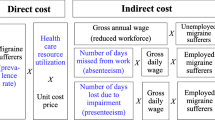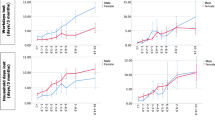Abstract
Objective: To calculate and compare the human capital approach (HCA) and friction cost approach (FCA) methods for estimating the cost of lost productivity of migraineurs after the initiation of sumatriptan from a US societal perspective.
Design: Secondary, retrospective analysis to a prospective observational study.
Setting: A mixed-model managed care organisation in western Pennsylvania, USA.
Patients: Patients with migraine using sumatriptan therapy.
Interventions: Patient-reported questionnaires collected at baseline, 3 and 6 months after initiation of sumatriptan therapy.
Outcome measures: The cost of lost productivity estimated with the HCA and FCA methods.
Results: Of the 178 patients who completed the study, 51% were full-time employees, 13% were part-time, 18% were not working and 17% changed work status. Twenty-four percent reported a clerical or administrative position. From the HCA, the estimated total cost of lost productivity for 6 months following the initiation of sumatriptan was $US117 905 (1996 values). From the FCA, the six-month estimated total cost of lost productivity ranged from $US28 329 to $US117 905 (1996 values).
Conclusions: This was the first study to retrospectively estimate lost productivity of patients with migraine using the FCA methodology. Our results demonstrate that depending on the assumptions and illustrations employed, the FCA can yield lost productivity estimates that vary greatly as a percentage of the HCAestimate. Prospective investigations are needed to better determine the components and the nature of the lost productivity for chronic episodic diseases such as migraine headache.



Similar content being viewed by others
References
Hu XH, Markson LE, Lipton RB, et al. Burden of migraine in the United States: disability and economic costs. Arch Intern Med 1999; 813–8
Osterhaus JT, Gutterman DL, Plachetka JR. Health care resource and lost labour costs of migraine headache in the US. Pharmacoeconomics 1992; 2: 67–76
Stewart WF, Linet MS, Van Natta M, et al. Age-and sex-specific incidence rates of migraine with and without visual aura. Am J Epidemiol 1991; 134: 1111–20
Stewart WF, Lipton RB, Celetano DD, et al. Prevalence of migraine headache in the Unites States: relation to age, income, race, and other sociodemographic factors. JAMA 1992; 267: 64–9
Stang PE, Osterhaus JT. Impact of migraine in the United States: data from the National Health Interview Survey. Headache 1993; 33: 29–35
Cortelli P, Dahlof C, Bouchard J, et al. A multinational investigation of the impact of subcutaneous sumatriptan III: workplace productivity and non-workplace activity. Pharmacoeconomics. 1997; 11 Suppl. 1: 35–42
Lofland JH, Johnson NE, Batenhorst AS, et al. Changes in resource use and outcomes for migraine patients treated with sumatriptan: a managed care perspective. Arch Intern Med 1999; 159: 857–63
Cohen JA, Beall DG, Miller DW, et al. Subcutaneous sumatriptan for the treatment of migraine: humanistic, economic, and clinical consequences. Fam Med 1996; 28: 171–7
Schwartz BS, Stewart WF, Lipton RB. Lost workdays and decreased work effectiveness associated with headache in the workplace. J Occup Environ Med 1997; 39: 320–7
Stang P, Cady RK, Batenhorst AS, et al. Workplace productivity: a review of the impact of migraine and its treatment. Pharmacoeconomics 2001; 19 (3): 231–44
Schulman EA, Cady RK, Henry D, et al. Effectiveness of sumatriptan in reducing productivity loss due to migraine: results of a randomized, double-blind, placebo-controlled clinical trial. Mayo Clin Proc 2000; 75: 782–9
Ferrari MD. The economic burden of migraine to society. Pharmacoeconomics 1998; 13 (6): 667–76
Johannesson M. The willingness to pay for health changes, the human capital cost approach and the external costs. Health Policy 1996; 36: 231–44
Koopmanschap MA, Rutten FF. A practical guide for calculating indirect costs of disease. Pharmacoeconomics 1996; 10 (5): 460–6
Koopmanschap MA, Rutten FF. Indirect costs in economic studies: confronting the confusion. Pharmacoeconomics 1993; 4 (6): 446–54
Salkever DS. Morbidity costs: national estimates and economic determinants. NCHSR Summary ser. Washington (DC): National Centre for Health Services Research, 1984
Van Roijen L, Essink-Bot ML, Koopmanschap MA, et al. Societal perspective on the burden of migraine in The Netherlands. Pharmacoeconomics 1995; 7: 170–9
Robinson JC. Philosophical origins of the economic valuation of life. Milbank Q 1986; 64 (1): 133–55
Koopmanschap MA, Rutten FFH, van Ineveld BM, et al. The friction cost method for measuring indirect costs of disease. J Health Econ 1995; 14: 171–89
Brouwer WBF, Koopmanschap MA. How to calculate indirect costs in economic evaluations. Pharmacoeconomics 1998; 13 (5 Pt 1) 563–6
DeLissovoy G, Lazarus SS. The economic cost of migraine: present state of knowledge. Neurology 1994; 14: 171–89
Peeples PJ, Wertheimer AI, Mackowiak JI, et al. Controversies in measuring and valuing indirect costs of productivity foregone in a cost of illness evaluation. J Res Pharm Econ 1997; 8 (3): 23–32
Liljas B. How to calculate indirect costs in economic evaluations. Pharmacoeconomics 1998; 13 (1 Pt 1): 1–7
Koopmanschap MA, van Ineveld BM. Towards a new approach for estimating indirect costs of disease. Soc Sci Med 1992; 34: 1005–10
Severens JL, Laheij RJF, Jansen JBMJ, et al. Estimating the cost of lost productivity in dyspepsia. Aliment Pharmacol Ther 1998; 12: 919–23
Gold MR, Siegel JE, Russell LB, et al., editors. Cost-effectiveness in health andmedicine. New York (NY): Oxford University Press, 1996
Liljas B. How to calculate indirect costs in economic evaluations [letter]. Pharmacoeconomics 1998; 13 (5 Pt 1): 566–9
Lofland JH, Kim SS, Batenhorst AS, et al. Cost effectiveness and cost benefit of sumatriptan for patients with migraine. Mayo Clin Proc. In press
Koopmanschap MA, Rutten FF. The impact of indirect costs on outcomes of health care programs. Health Economics 1994; 3: 385–93
US Bureau of Labor Statistics. Occupational wage rates, January 1998 [online]. Available from URL: http://www.bls.gov/cpsaatab.htm#weekearn [Accessed Mar 1998]
US Bureau of Labor Statistics. Publication directory [online]. Available from URL: ftp://ftp.bls.gov/pub/news.release/ History/ecec.061894.news [Accessed Mar 1998]
Legg RF, Sclar DA, Nemec NL, et al. Cost benefit of sumatriptan to an employer. J Occup Environ Med 1997; 39: 654–7
Andrasik F, Kabela E, Quinn S, et al. Psychological functioning of children who have recurrent migraine. Pain 1988; 34 (1): 43–52
Devlen J. Anxiety and depression in migraine. J R Soc Med 1994; 87 (6): 338–41
Acknowledgements
This work was sponsored by GlaxoSmithKline, Inc.
We would like to gratefully acknowledge Alice S. Batenhorst, PharmD (GlaxoSmithKline, Inc.) and Mary Lou Chatterton, PharmD (Thomas Jefferson University, Office of Health Policy and Clinical Outcomes) for their contributions.
Author information
Authors and Affiliations
Corresponding author
Additional information
At the time of this project, Dr Locklear was an Outcomes Research Fellow in the Office of Health Policy and Clinical Outcomes, Thomas Jefferson University, Philadelphia, Pennsylvania, USA.
Rights and permissions
About this article
Cite this article
Lofland, J.H., Locklear, J.C. & Frick, K.D. Different Approaches To Valuing the Lost Productivity of Patients with Migraine. Pharmacoeconomics 19, 917–925 (2001). https://doi.org/10.2165/00019053-200119090-00003
Published:
Issue Date:
DOI: https://doi.org/10.2165/00019053-200119090-00003




